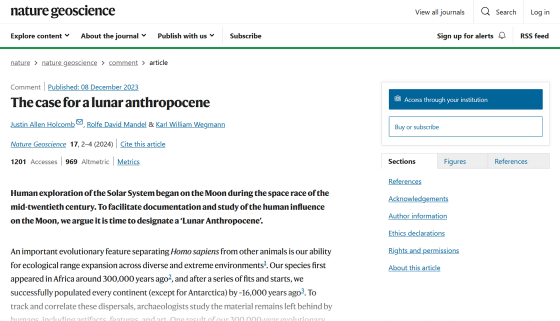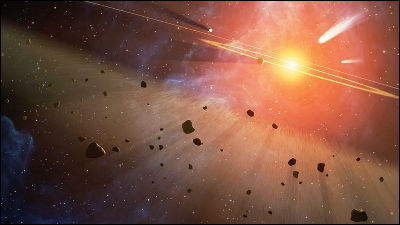Researchers claim that the time has come for humans to change the environment on the moon, and we have entered a new geological era on the moon, the ``Lunar Anthropocene.''

by
In 1959, Luna 2 , a spacecraft launched by the Soviet Union, became the first human-made object to reach the moon's surface. Since then, humans have sent more than 100 lunar probes and manned spacecraft to the moon, and astronauts actually landed on the moon during the Apollo program, making great changes to the lunar environment. In response to this situation, Justin Holcomb, a geologist at the University of Kansas in the United States, and his colleagues say the moon has entered a new geological epoch , the Lunar Anthropocene , in the peer-reviewed academic journal Nature. This is claimed in a paper published in Geoscience .
The case for a lunar anthropocene | Nature Geoscience
https://www.nature.com/articles/s41561-023-01347-4

Scholars say it's time to declare a new epoch on the moon, the 'Lunar Anthropocene' | The University of Kansas
https://news.ku.edu/2023/12/08/scholars-say-its-time-declare-new-epoch-moon-lunar-anthropocene
Humans are changing the moon's surface so much it's entered a new geological era, scientists say | Live Science
https://www.livescience.com/space/the-moon/humans-are-changing-the-moons-surface-so-much-its-entered-a-new-geological-era-scientists-say
In terms of geological time, modern times correspond to the Holocene epoch, which began approximately 10,000 years ago. However, in recent years, attention has been focused on the effects of human-induced global warming, the extinction of living things, and changes in sediments due to nuclear testing, and there has been a movement to refer to a narrower area closer to modern times as the ' Anthropocene .'
In response, Holcomb et al. said, ``Human cultural processes are beginning to outweigh the natural geological background of the lunar surface,'' and ``We need to discuss human impact on the lunar surface before it's too late.'' We aim to begin this new lunar era,' he said, naming the new lunar era the 'Lunar Anthropocene.'
There are various theories about the beginning of the Anthropocene, with some saying it started at the beginning of the industrial revolution, and others saying it started at the time the first atomic bomb exploded. However, the beginning of the lunar Anthropocene is more clear-cut, starting in 1959 when Luna 2 became the first man-made object to impact the moon's surface and the first man-made crater was formed.

by
Since the first man-made objects arrived on the moon, humans have created a variety of things, including the footprints of lunar probes and their wheels, human footprints, golf balls hit by astronauts , flags , and bags of excrement. I left it on the moon.
At first glance, it may not seem like a huge amount, but the research team points out that these human activities are more important than they appear. In the first place, the moon's surface has no atmosphere or active crustal movement, so the rocks and surface of the moon are not eroded by wind or rain. Therefore, once a crater is created by a meteorite or similar collision, its traces will continue to remain as a crater for millions to billions of years, unlike on Earth. In other words, the impact humans have on the lunar surface will basically be semi-permanent.
JAXA's lunar probe 'SLIM' just landed on the moon on January 20, 2024 (Japan time), and NASA'sArtemis mission, a manned lunar exploration mission, is planned for 2026. , China and India are also planning manned moon exploration. Therefore, Professor Jean -Peter Muller of University College London points out that there is value in recognizing that ``humankind is having an impact on the moon.''

In addition, the research team's goal in proposing the lunar anthropocene is not only to raise awareness of the impact humans are having on the lunar surface, but also to draw attention to the protection of humanity's important 'cosmic heritage.' It is said that there is also a point. The research team argues that just as there is already a growing momentum to preserve the artifacts and art left by human ancestors on Earth, the remains of humanity that show that we have expanded into the solar system should also be preserved. .
Holcomb said, ``A recurring theme in our research is that the moon's resources and human footprints are both valuable, and the archaeological record we are working hard to preserve will continue to grow.'' The concept of the Lunar Anthropocene is intended to encourage awareness and reflection about our impact on the lunar surface and the preservation of historical artifacts.'
Related Posts:
in Science, Posted by log1h_ik







